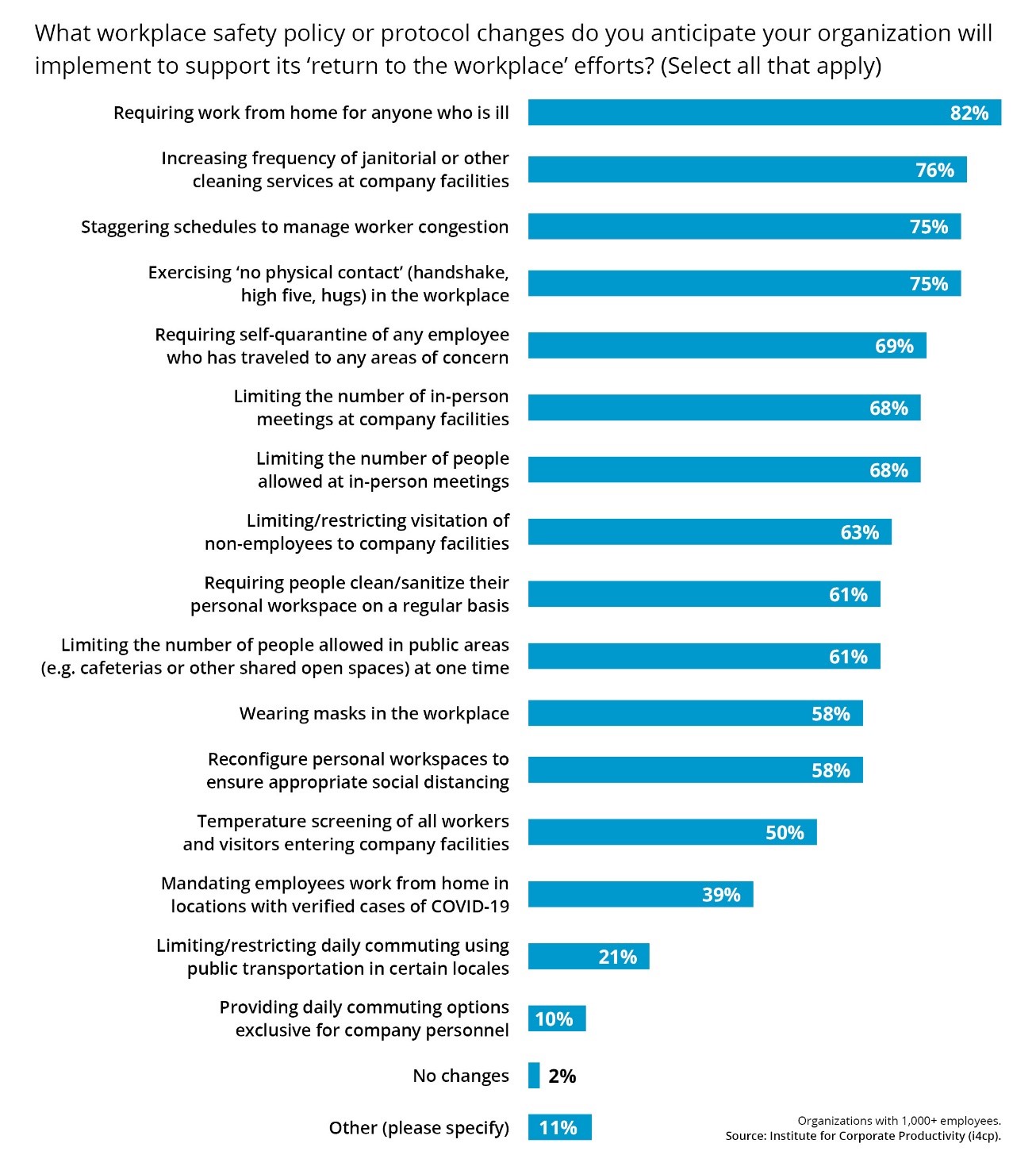Return to the Workplace: The Numerous and Nuanced Decisions for Employers

65% of organizations have dedicated teams or task forces in place charged with return to the workplace strategy
Nearly all employers are planning for a phased return to the workplace and staggered schedules; 63% will provide employees who have childcare responsibilities with special consideration and enhanced flexibility
Many in the media and in governments at all levels are increasingly talking of how and when to “get America back to work again.” Naturally for companies that have had to suspend operations, this is an urgent question. For those (and far more) organizations where work never stopped because employees continued to work from home, the broader question is how to plan for a return to the traditional workplace.
The focus of the most recent survey by the Institute for Corporate Productivity (i4cp), which gathered over 300 responses from HR leaders of companies with 1,000 or more employees, is a look at how employers plan to navigate returning employees to the workplace.
The survey explores the many nuances of this undertaking, such as the high-level guidelines provided by governors, who ultimately determine how and when people come back to their traditional workplaces, as well as other concerns and considerations.
Most organizations have deployed a planning strategy—nearly two-thirds (65%) of respondents indicated their organization already has a dedicated team or task force charged with its return to the workplace strategy, and another 26% noted their organization is considering it.
These teams or task forces are a shared responsibility of the executive leadership team in 37% of organizations. In terms of the makeup of the teams, the most common individual role involved is the Chief Human Resources Officer (72%), followed by the corporate communications leader (57%), select business unit leaders (53%), general counsel / legal (48%), and the environmental health & safety leader (41%). A wide range of other key positions are variously involved including the CEO, CFO, top IT leader, corporate real estate leader, and many others.
Respondents universally said their organizations will follow the guidelines set by the respective governors and leaders in each global geography. But those guidelines are high-level and are only a starting point, leaving numerous and complex decisions up to each employer.
The importance and impact of return to the workplace decisions are increasingly consuming more energy among senior leadership teams; up to 65% of survey respondents said that this is consuming 25% of the collective energy of leadership, and 31% reported that up to 50% or more of their senior leadership’s collective energy is focused on this monumental task.
One concern expressed by many respondents is the desire to avoid a premature return to the workplace, and the potential of having to close down the workplace again should the virus reignite, etc.
A common dilemma is the question of what is best done in the traditional workplace vs. what can be done well (or in some cases, more productively) from home. Employers are also very focused on how to make employees feel safe, even if that means taking steps beyond what is necessary for them to actually be safe, as it is perceptions and feelings that will ultimately keep engagement, morale, and productivity high.
Almost universally, survey respondents said that their organizations are likely to have a phased return to the workplace strategy, with employees coming back in waves based on a variety of factors. In terms of communication, some noted it will amount to phases of allowing, encouraging, and then later recommending a return, spread out over weeks if not months.
Some indicated they are considering staggered returns to the workplace, using shift rotations for morning/evening or by day of the week, in order to limit the total number of employees at the workplace at any one time. Some are prioritizing critical roles, while being careful with messaging so that all employees continue to feel valued. And for some organizations, there are important geographic considerations, with different plans for cities with mass transit and elevators in tall buildings vs. locations with flatter campuses and most employees driving themselves to work.
Special Considerations
Survey respondents made clear that some employees might need special consideration as part of an organization’s return to the workplace strategy. Nearly two-thirds indicated that employees with childcare responsibilities would garner some special consideration, with the top two approaches being flexibility in allowing them to continue to work remotely or allowing for flexible work schedules where possible (i.e., ability to adjust days and hours.)
Other groups most likely to be given special consideration included employees with eldercare responsibilities (45%), employees who never stopped working onsite (43%), employees in customer-facing roles (42%) and, not surprisingly, employees who have tested positive for COVID-19.
What exactly organizations might do to help ensure workplace safety, in terms of policy or protocol changes, is still very fluid and varies widely across organizations. The most common measures cited are the most obvious measures—requiring work from home for anyone who is or has been ill (82%), increasing the frequency of cleaning services (76%), and requiring self-quarantine for anyone who has traveled to an area of concern (69%).

Several other common strategies cited focus on ways to implement social distancing at the workplace, including staggering schedules to manage worker congestion (75%), creating policies that address physical contact such as handshakes or high fives (75%), limiting the number of in-person meetings or people attending such meetings (68%), limiting the number of people allowed in common areas such as break rooms or cafeterias (61%), and reconfiguring personal workspaces (58%).






